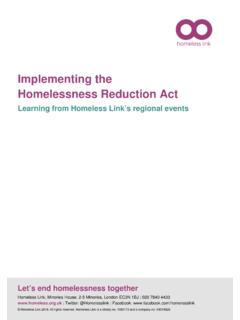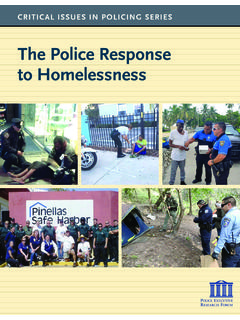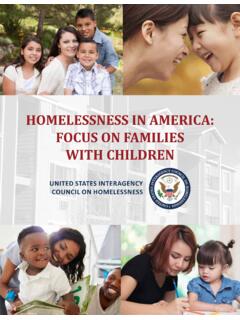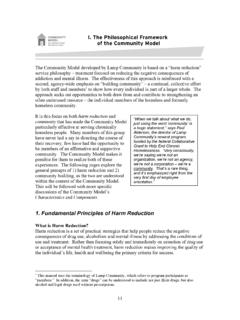Transcription of The homelessness monitor: England 2018
1 XxxxxxxThe homelessness monitor: England 2018 Suzanne Fitzpatrick, Hal Pawson, Glen Bramley, Steve Wilcox, Beth Watts & Jenny Wood, Institute for Social Policy, Environment and Real Estate (I-SPHERE), Heriot-Watt University; City Futures Research Centre, University of New South 2018 The homelessness monitor: England 2018iiThe homelessness monitor The homelessness monitor is a longitudinal study providing an independent analysis of the homelessness impacts of recent economic and policy developments in England . It considers both the consequences of the post-2007 economic and housing market recession, and the subsequent recovery, and also the impact of policy seventh annual report updates our account of how homelessness stands in England in 2018, or as close to 2018 as data availability allows. It also highlights emerging trends and forecasts some of the likely future changes, identifying the developments likely to have the most significant impacts on this report focuses on England , parallel homelessness Monitors are being published for other parts of the homelessness monitor: England 2018 Suzanne Fitzpatrick, Hal Pawson, Glen Bramley, Steve Wilcox, Beth Watts & Jenny Wood, Institute for Social Policy, Environment and Real Estate (I-SPHERE), Heriot-Watt University; City Futures Research Centre, University of New South 2018 The homelessness monitor: England 2018ivAbout Crisis UKCrisis is the national charity for homeless people.
2 We help people directly out of homelessness , and campaign for the social changes needed to solve it altogether. We know that together we can end the authorsProfessor Suzanne Fitzpatrick, Professor Glen Bramley, Dr Beth Watts and Dr Jenny Wood are all based at the Institute for Social Policy, Housing and Equalities Research (I-SPHERE) at Heriot-Watt University. Professor Hal Pawson is based at the City Futures Research Centre, University of New South Wales. Steve Wilcox is a former Professor at the Centre for Housing Policy, University of York. Crisis head office66 Commercial StreetLondon E1 6 LTTel: 0300 636 1967 Fax: 0300 636 Crisis 2018 ISBN 978-1-78519-048-3 Crisis UK (trading as Crisis). Registered Charity Numbers:E&W1082947, SC040094. Company Number: 4024938vAcknowledgementsThis report was commissioned by Crisis and funded by Crisis and the Joseph Rowntree Foundation, and our thanks go to Francesca Albanese, Ben Sanders and Matt Downie at Crisis, and Brian Robson and Emma Stone at Joseph Rowntree Foundation, for all of their support with this work.
3 We are also very grateful to the two local authorities who kindly piloted it for us. We are very grateful to Jeremy Swain, Thames Reach, for his valuable comments on the rough sleeping sections of the report. In addition, we are extremely grateful to all of the key informants from the statutory and voluntary sector organisations across England who found time in their busy schedules to help us with this study. Our thanks also to Paul Cosgrove for his help with the online survey, and to Katie Colliver for her invaluable assistance with editing and : All views and any errors contained in this report are the responsibility of the authors. The views expressed should not be assumed to be those of Crisis, the Joseph Rowntree Foundation or of any of the key informants who assisted with this homelessness monitor: England 2018viContentsFigures and Tables viiAcronyms ixForeword xExecutive summary xi1.
4 Introduction Introduction Definition of homelessness Research methods Causation and homelessness Structure of report 32. Economic factors that may impact on homelessness 4 in England Introduction The broader economic context Housing demand and supply Access to home ownership Access to social and affordable housing Access to private rented housing Key points 143. Government policies potentially impacting 16 on homelessness in England Introduction homelessness policies Welfare policies Key points 454. homelessness trends in England Introduction Rough sleeping Single homelessness Statutory homelessness Local authority homelessness prevention and relief Hidden homelessness Key points 755. Conclusions 77 Appendix 1 Topic Guide (2017) 81 Appendix 2 Local Authority Survey (2017) 83 Bibliography 88viiExecutive SummaryTable Summary of homelessness Statistics xvChapter 2 Figure English earnings recovery still not in sight 5 Figure House building needs to continue to rise to match 6 projected households growthFigure Percentage change in house prices between 2007 and 2016 7 Figure Mortgage arrears and repossessions continue to fall 8 Figure Slight recovery in supply of affordable housing 9 Figure Social sector lettings to new tenants much lower than 10 in the 1990sFigure Social landlord possession orders and repossessions 11 in England ease further back in 2016 Figure Growth of private rented sector continues 13 Chapter 3 Figure Local authority preparations for the homelessness 24 Reduction Act regimeFigure Tightening of the Maximum Benefit Cap 37 Figure Sharp rise in benefit cap cases outside London
5 After 37 November 2016 lowering of the capFigure Impact of universal credit reforms on total net income 40 after housing costs (AHC) Chapter 4 Figure Trends in local authority rough sleeper estimates 49 by region, 2004-2017 Figure Has rough sleeping increased in your area over the 51 past year? (%)Figure Are further resources or provision needed to address 52 rough sleeping in your area? Figure Rough sleeping in London 2007/08-2016/17: breakdown 54 by nationality Figure London rough sleepers by nationality: Q4 enumeration 54 2013-2017 Figure Rough sleeping in London 2007/08-2016/17: breakdown 57 by stock/ flow/ returnerFigure Trend in single person households accepted as 58 unintentionally homeless and in priority need, 2009/10-2016/17 Figure Statutory homelessness assessment decisions, 59 2008/09-2016/17 Figure Change in overall homelessness expressed demand 61 in 2016/17 Figures and TablesThe homelessness monitor: England 2018viiiFigure homelessness acceptances, 2008/09-2016/17.
6 Trends 62 at broad region level indexedFigure Change in number of households made homeless due to 63 selected immediate causes, 2008/09-2016/17 indexedFigure Local authorities use of temporary accommodation 65 for homeless householdsFigure Overview of local authority action to assist homeless 65 (and potentially homeless) households, 2009/10-2016/17 Figure Local authority homelessness prevention and relief activity, 66 2009/10-2016/17 Figure Households containing potentially concealed households 69 by tenure, England 2017 Figure New household forming rate and individual concealed 69 households, England 1992-2015 Figure New household formation rates by tenure, England 71 2007-15 (percent of households in each tenure) Figure Headship rates for 20-29 year olds, selected English 71 Regions 1992-2017 Figure Sharing by Household Type and Tenure, England , 73 2016 and 2017 Figure Sharing households in England 1992-2016 (per cent) 73 Figure Overcrowding by tenure in England 1995-2014 (per cent)
7 74 ixAcronyms B&B Bed and BreakfastBTL Buy to LetCEE Central and Eastern EuropeanCHAIN Multi-agency database recording information about rough sleepers and the wider street population in LondonCPI Consumer Price IndexDCLG Department for Communities and Local GovernmentDWP Department for Work and PensionsEHS English Housing SurveyHB Housing BenefitHtB Help to BuyHRA homelessness Reduction ActH-CLIC Case-level statutory homelessness data collection toolLA Local AuthorityLFS Labour Force SurveyLHA Local Housing AllowanceMHCLG Ministry of Housing, Communities and Local GovernmentNAO National Audit OfficeP1E Government statistical return on homelessnessPAC Public Accounts CommitteePRS Private Rented SectorSAR Shared Accommodation RateTA Temporary AccommodationUC Universal CreditUKSA UK Statistics Authority The homelessness monitor: England 2018xJon SparkesChief Executive, CrisisCampbell RobbChief Executive, Joseph Rowntree FoundationForewordThe homelessness monitor England 2018 is the seventh instalment of an annual state-of-the-nation report looking at the impact of economic and policy developments on on statistical analysis, insights from a large scale survey with local authorities and in-depth interviews with key informants, this year s monitor reveals how desperate the situation has become for homeless households trying to find somewhere to live.
8 Councils across the country are struggling to house people because of a decline in social housing, spiralling private rents, and welfare cuts. Councils also reported a growing reluctance among landlords to rent to people on welfare, with many worried that formerly homeless tenants would struggle to pay rent and , the number of homeless families and individuals placed in temporary accommodation jumped to 78,000 last year, an 8% rise on the year and a massive 60% rise since 2012. The number of homeless households placed in B&Bs which are often cramped, unsuitable, and sometimes even dangerous rose particularly quickly, with a 10% rise on the year. If trends continue as they are the research reveals that 100,000 households will be living in B&Bs, hostels and other temporary monitor shows that homelessness is rising across the country and in particular outside the capital. This time last year the homelessness Reduction Bill was passing through parliament. It has now become law and places a statutory duty on councils to help people who are homeless or at risk of homelessness .
9 This could make a significant government s recent actions on homelessness including the pledge to end rough sleeping by 2027, and the establishment of the homelessness and Rough Sleeping Implementation Taskforce is welcome. Yet while the homelessness Reduction Act is a positive step forward, there remains pressing structural issues driving homelessness . More social housing needs to be built and homeless people need to be able to access year s monitor explores all these issues in detail and gives the most up to date and authoritative overview of the state of homelessness in England today. It is invaluable tool for those interested in understanding homelessness and seeking to end SummaryExecutive summaryKey points1 Parallel homelessness Monitors are being published for Scotland, Wales and Northern Ireland. All of the UK homelessness Monitor reports are available from Multi-agency database recording information about rough sleepers and the wider street population in LondonThe homelessness Monitor series is a longitudinal study providing an independent analysis of the homelessness impacts of recent economic and policy developments in England and elsewhere in the This seventh annual report for England updates our account of how homelessness stands in 2018, or as close to 2018 as data availability points to emerge from our latest analysis are as follows: homelessness has shot up the media and political agenda over the past year.
10 All of the major party manifestos made mention of homelessness in the snap June 2017 election, and the Conservatives under Theresa May pledged to halve rough sleeping by 2022 and eliminate it altogether by 2027. The Prime Minister has also established a high-level Rough Sleeping and homelessness Reduction Taskforce supported by an expert Rough Sleeping Advisory Panel. This political attention is in large part a response to the ongoing rise in officially estimated rough sleeper numbers, with the national total now up by 169 per cent since 2010. The more robust statistics routinely collected by the CHAIN2 system similarly show London rough sleeping having more than doubled since 2010. Latest figures show London rough sleeping involving UK nationals continuing to increase very slightly. However, thanks to a sharp contraction in street homelessness involving those of Central and Eastern European and other non-UK origin, overall London rough sleeping has marginally reduced since 2015.









